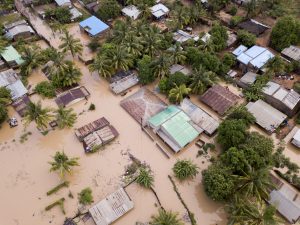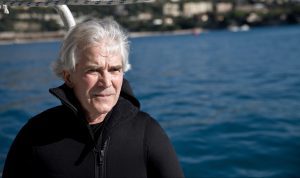This research digest quantifies the scale of ocean-based approaches to help close the mitigation gap and sheds light on the process for harnessing this potential.
Despite playing a central role in buffering the planet from soaring temperatures, the ocean has been mostly absent, until recently, from policy discussions and philanthropic strategies aimed at reducing carbon emissions and addressing the stark challenges of climate change. The ocean has absorbed the vast majority of global warming heat to date—roughly 93 percent of excess heat energy since the 1970s—leading the International Union for the Conservation of Nature (IUCN) to describe the accelerated warming of the ocean as “the greatest hidden challenge of our generation.”
The past few months have seen a growing evidence base and recognition of opportunities for the ocean to play a significant role in the climate mitigation agenda. Policy discussions are pivoting from framing the ocean as a silent, if not underappreciated, buffer against warming to a powerful source for reducing emissions. Even marine conservation philanthropies and nonprofit organizations have historically adopted strategies to adapt to the symptoms of climate change. Examples of these strategies include improving the resilience of marine ecosystems by reducing local stressors or making fisheries management more adaptive to climate-induced changes. Under this frame, the role of reducing greenhouse gas emissions was left to stakeholders focused on climate change, for whom ocean-based solutions have not been a priority to date.
The historical silos between the ocean conservation and climate mitigation communities are beginning to fade as new information and analyses suggest the ocean could be a source of solutions that address the causes of climate change, providing hope that limiting warming to the 1.5 degrees Celsius target might be possible. These new insights couldn’t come at a better time. As the global ocean becomes warmer, rises higher, loses oxygen, and becomes more acidic at an ever-faster pace, major steps towards mitigation are required to maintain key ecosystem services and societal benefits that the ocean provides—from coastal protection and food security to economic livelihoods and cultural and recreational value. Without major changes, the mounting impacts of climate change will inevitably overwhelm marine conservation efforts.
As the global ocean becomes warmer, rises higher, loses oxygen, and becomes more acidic at an ever-faster pace, major steps towards mitigation are required to maintain key ecosystem services and societal benefits that the ocean provides. Without major changes, the mounting impacts of climate change will inevitably overwhelm marine conservation efforts.
This shift in thinking reached global scale during the most recent Climate Week in New York. During the events, the Intergovernmental Panel on Climate Change (IPCC) released the “Special Report on the Ocean and Cryosphere in Changing Climate” which outlines the unprecedented changes happening in our shared seas.
Two of the heads of state who highlighted the IPCC report’s findings are also members of the High Level Panel for a Sustainable Ocean Economy, whose recent report—“The Ocean as a Solution for Climate Change: 5 Opportunities for Action”—highlights the potential of the ocean to reduce greenhouse gas emissions. The High Level Panel report finds that ocean-related actions could reduce annual emissions by up to 11 billion tonnes of carbon dioxide equivalents (CO2e), or 21 percent of the additional emissions reductions required by 2050 to limit warming to 1.5 degrees Celsius (and 25 percent of emissions reduction for a 2 degrees Celsius target).
The High Level Panel report finds that ocean-related actions could reduce annual emissions by up to 11 billion tonnes of carbon dioxide equivalents (CO2e), or 21 percent of the additional emissions reductions required by 2050 to limit warming to 1.5 degrees Celsius.
The panel’s analysis highlighted five main opportunities for emissions reductions:
- Ocean-based renewable energy (i.e., offshore wind)
- Ocean-based transport (i.e., shipping)
- Coastal and marine ecosystems (e.g., mangroves, seagrasses, salt marshes)
- Fisheries, aquaculture, and dietary choice
- Carbon storage in the seabed
In a conservative mitigation scenario, ocean-based approaches could provide about 3 billion tons of carbon dioxide equivalents (GtCO2e) mitigation opportunities in 2050. Using more aggressive scenarios, ocean-related mitigation could provide roughly 11.8 billion tons of carbon dioxide equivalents (GtCO2e) in 2050.
Marine renewable energy—as our interview with Dr. Jean-Pierre Gattuso (a lead author of the IPCC Special Report) also highlights—is a promising mitigation opportunity given that offshore wind is ready for large-scale deployment. Another area highlighted in the High Level Panel Report—the protection and restoration of coastal ecosystems or “blue carbon”—represents a “no-regrets” mitigation measure. The avoided conversion and restoration of blue carbon ecosystems (including mangroves, salt marshes, and seagrasses) provides a relatively modest contribution to overall emissions reduction; the High Level Panel estimates that it represents only about 1 to 2 percent of current carbon dioxide emissions. Yet this approach is considered a “no-regrets” option for the considerable co-benefits that these ecosystems provide, from storing carbon and protecting coastlines from storms and erosion to sustaining biodiversity and providing food security for coastal communities. Thus, there is untapped opportunity to prevent the deforestation or conversion of blue carbon ecosystems, in addition to restoring degraded blue carbon ecosystems.
The total carbon stock stored in coastal ecosystems is limited in comparison to that stored in terrestrial forests, due to the wider territorial extent of terrestrial forests. However, per unit area, marine ecosystems store substantially more carbon than terrestrial ecosystems, meaning that blue carbon ecosystems provide “more bang for the buck” from a carbon storage perspective. Mangroves, salt marshes, and sea grasses have concentrated levels of soil organic carbon—up to ten times that of tropical forests—but only cover 1 to 2 percent of the area of terrestrial forests.
Blue carbon ecosystems provide “more bang for the buck” from a carbon storage perspective. Mangroves, salt marshes, and sea grasses have concentrated levels of soil organic carbon—up to ten times that of tropical forests—but only cover 1 to 2 percent of the area of terrestrial forests.
There are several countries which are hotpots for mangrove conversion, and thus offer valuable insights on where to focus efforts for avoided conversion and restoration of mangroves. As the map below indicates, the three countries with the highest mangrove mitigation potential are: Indonesia, Malaysia, and Myanmar. This type of information can help guide both policymakers and conservation stakeholders in understanding where to prioritize efforts for blue carbon conservation and restoration.
In addition to these approaches, other nature-based solutions such as increasing fish biomass or “whale carbon” are being explored as carbon sink opportunities, but the science is not clear enough to quantify their abatement potential. Similarly, geoengineering approaches such as ocean fertilization, artificial upwelling, and enhanced ocean alkalinity could have significant mitigation benefits. However, there is still significant uncertainty about their overall potential and possible negative impacts on ocean ecosystems.
Conclusion
There is a narrow window of opportunity to shift the global emissions pathway towards a trajectory that is consistent with limiting warming to less than 1.5 degrees Celsius. These ocean-based approaches provide additional options at a time when an all-hands-on-deck approach is needed.
Additional work is needed to answer critical questions about these approaches and to break down barriers to their adoption, in order to transform these opportunities into becoming reality. Some of the outstanding questions include:
- How do we advance a stable regulatory framework for offshore wind?
- How should the ocean conservation community balance concerns about increased seafood production with the climate benefits of higher seafood consumption?
- Should the ocean conservation community support subsea carbon capture and storage (CCS) – what are the tradeoffs of associated benefits and risks?
The IPCC’s Special Report has brought into focus the urgency of ambitious action to mitigate climate change, while the High Level Panel report has raised the profile of the ocean as a source of solutions. All stakeholders—from marine conservation funders and NGO practitioners to policymakers and resource managers—will need to grapple with these questions in order to leverage the potential of ocean-based measures to help solve the climate crisis. The timing could not be more urgent, particularly as climate scientists have warmed that there is only about one decade to limit warming to 1.5 degrees Celsius.
Mark Michelin is a Director and Emily Peterson is a Senior Associate at CEA Consulting. They are focused on strategic planning for foundations and nonprofits in the marine conservation sector.



